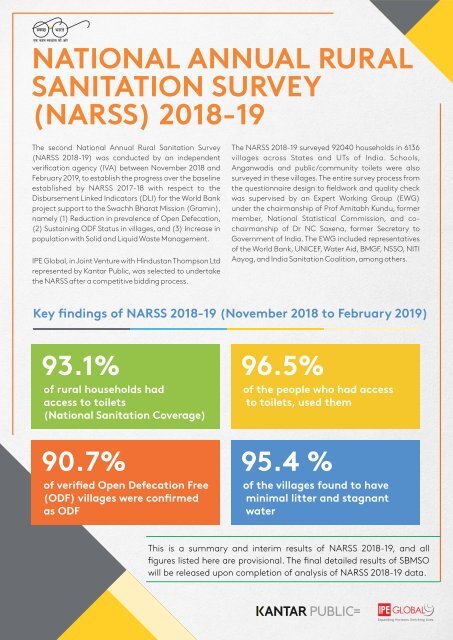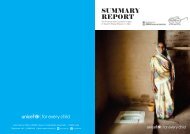Ministry of Jal Shakti, National Annual Rural Sanitation Survey, 2018-19
- No tags were found...
Create successful ePaper yourself
Turn your PDF publications into a flip-book with our unique Google optimized e-Paper software.
NATIONAL ANNUAL RURAL<br />
SANITATION SURVEY<br />
(NARSS) <strong>2018</strong>-<strong>19</strong><br />
The second <strong>National</strong> <strong>Annual</strong> <strong>Rural</strong> <strong>Sanitation</strong> <strong>Survey</strong><br />
(NARSS <strong>2018</strong>-<strong>19</strong>) was conducted by an independent<br />
veri cation agency (IVA) between November <strong>2018</strong> and<br />
February 20<strong>19</strong>, to establish the progress over the baseline<br />
established by NARSS 2017-18 with respect to the<br />
Disbursement Linked Indicators (DLI) for the World Bank<br />
project support to the Swachh Bharat Mission (Gramin),<br />
namely (1) Reduction in prevalence <strong>of</strong> Open Defecation,<br />
(2) Sustaining ODF Status in villages, and (3) Increase in<br />
population with Solid and Liquid Waste Management.<br />
IPE Global, in Joint Venture with Hindustan Thompson Ltd<br />
represented by Kantar Public, was selected to undertake<br />
the NARSS after a competitive bidding process.<br />
The NARSS <strong>2018</strong>-<strong>19</strong> surveyed 92040 households in 6136<br />
villages across States and UTs <strong>of</strong> India. Schools,<br />
Anganwadis and public/community toilets were also<br />
surveyed in these villages. The entire survey process from<br />
the questionnaire design to eldwork and quality check<br />
was supervised by an Expert Working Group (EWG)<br />
under the chairmanship <strong>of</strong> Pr<strong>of</strong> Amitabh Kundu, former<br />
member, <strong>National</strong> Statistical Commission, and cochairmanship<br />
<strong>of</strong> Dr NC Saxena, former Secretary to<br />
Government <strong>of</strong> India. The EWG included representatives<br />
<strong>of</strong> the World Bank, UNICEF, Water Aid, BMGF, NSSO, NITI<br />
Aayog, and India <strong>Sanitation</strong> Coalition, among others.<br />
Key ndings <strong>of</strong> NARSS <strong>2018</strong>-<strong>19</strong> (November <strong>2018</strong> to February 20<strong>19</strong>)<br />
93.1%<br />
<strong>of</strong> rural households had<br />
access to toilets<br />
(<strong>National</strong> <strong>Sanitation</strong> Coverage)<br />
90.7%<br />
<strong>of</strong> veri ed Open Defecation Free<br />
(ODF) villages were con rmed<br />
as ODF<br />
96.5%<br />
<strong>of</strong> the people who had access<br />
to toilets, used them<br />
95.4 %<br />
<strong>of</strong> the villages found to have<br />
minimal litter and stagnant<br />
water<br />
This is a summary and interim results <strong>of</strong> NARSS <strong>2018</strong>-<strong>19</strong>, and all<br />
gures listed here are provisional. The nal detailed results <strong>of</strong> SBMSO<br />
will be released upon completion <strong>of</strong> analysis <strong>of</strong> NARSS <strong>2018</strong>-<strong>19</strong> data.
<strong>Survey</strong> Approach & Sample Size NARSS <strong>2018</strong>-<strong>19</strong>:<br />
As per the survey protocol approved by the EWG, the<br />
NARSS covered 6136 sampled villages. All <strong>of</strong> these<br />
villages were studied for reduction in prevalence <strong>of</strong> open<br />
defecation (sanitation coverage and usage) and<br />
increase in population with solid and liquid waste<br />
management.<br />
Of these 6136 villages, 2891 villages were ODF-veri ed as<br />
on 6th June <strong>2018</strong> (the cut-o date to determine the<br />
proportion <strong>of</strong> rural population living in ODF areas for the<br />
purpose <strong>of</strong> the survey, as determined by the EWG). These<br />
2891 villages were additionally studied for their ODF<br />
sustainability.<br />
In each <strong>of</strong> the 6136 villages, the toilet coverage and usage<br />
survey included Households, Schools, Anganwadis and<br />
Public / Community toilets. In addition, the overall village<br />
surroundings were observed for the presence <strong>of</strong> litter,<br />
stagnant water and fecal matter.<br />
• Within each State/UT, the sample size is statistically<br />
signi cant for ODF Veri ed and other villages, and is<br />
proportionate to the total rural households in ODF<br />
veri ed and non-ODF villages in that State/UT.<br />
• About 200 households were listed in each village (over<br />
12 lakh households across the country). Of these, 20<br />
households per village were randomly selected through<br />
CAPI (Computer Assisted Personalized Interview), <strong>of</strong><br />
which the rst 15 were surveyed. The remaining ve<br />
households were kept in reserve as a bu er for situations<br />
where one <strong>of</strong> the original 15 households was locked or<br />
declined to respond.<br />
• Additionally, a school, anganwadi, public/community<br />
toilets and open spaces in each village were also<br />
surveyed.<br />
• The above sampling design yields results within a 95%<br />
con dence interval.<br />
• The sample for each State/UT is statistically signi cant,<br />
and is proportionate to the total rural households in that<br />
state/UT.<br />
The sampling methodology used was PPS (Population<br />
Proportion to Size). The sample size used for each<br />
category <strong>of</strong> the survey is as follows:<br />
<strong>Survey</strong> Component<br />
SAMPLE SIZE<br />
Sample Size per<br />
Villages (PSU)<br />
All India<br />
ODF veri ed<br />
villages<br />
Other villages<br />
Households 15 92, 040 43 , 365 48, 675<br />
Govt. School 1 6 , 136 2 , 891 3, 245<br />
Govt.Anganwadi Centre 1 6 , 136 2 , 891 3, 245<br />
Public/Community Toilet 1 6 , 136 2, 891 3, 245<br />
Observation <strong>of</strong> Public Places<br />
All <strong>Survey</strong>ed Villages
<strong>Survey</strong> Design NARSS <strong>2018</strong>-<strong>19</strong>:<br />
NARSS measures the<br />
outcomes on the basis <strong>of</strong><br />
World Bank's Disbursement<br />
Linked Indicators (DLI)<br />
World Bank<br />
Disbursement<br />
Linked<br />
Indicator<br />
1<br />
3<br />
2<br />
Reduction in prevalence <strong>of</strong><br />
open defecation<br />
Sustain ODF status<br />
in villages<br />
Increase in population with<br />
solid and liquid waste<br />
management<br />
Data Collection methodology<br />
Data was collected using CAPI (Computer Assisted Personal Interviewing) and was<br />
stored in a secured cloud-based server<br />
Cloud based<br />
Server<br />
Obtain<br />
Village<br />
Pro le<br />
Settlement Mapping<br />
& Segmentation<br />
through CAPI<br />
Household<br />
listing<br />
CAPI driven<br />
Household<br />
selection &<br />
HH <strong>Survey</strong><br />
Village<br />
<strong>Survey</strong><br />
Quality<br />
Checks<br />
Identi cation <strong>of</strong><br />
the eligible<br />
households by<br />
listing exercise<br />
Team visit and<br />
obtaining<br />
consent and<br />
assent<br />
Respondent<br />
Interviews in<br />
CAPI<br />
Final Data<br />
Upload
Provisional Findings NARSS <strong>2018</strong>-<strong>19</strong>:<br />
1. ODF survey<br />
An ODF-veri ed village is con rmed to be ODF if, during<br />
the survey, it is found that:<br />
• All households and all public institutions surveyed<br />
found to be using safe technology for disposal <strong>of</strong> faeces<br />
• No visible faeces found in the village surroundings<br />
2622 villages (90.7%) <strong>of</strong> all 2891 ODF-veri ed villages<br />
surveyed were con rmed to be ODF. The remaining 269<br />
villages (9.3%) were not con rmed ODF due to any <strong>of</strong> the<br />
following reasons:<br />
1. Lower than 100% access to toilets in the village<br />
2. Presence <strong>of</strong> unhygienic/dysfunctional/unsafe toilet in<br />
any household in the village<br />
3. Non-usage <strong>of</strong> a toilet by the household members<br />
4. Non-access <strong>of</strong> a toilet in schools or anganwadis<br />
5. Presence <strong>of</strong> visible fecal matter in the village.<br />
It may be noted that the average access to toilets in<br />
these 269 villages was about 93%.<br />
% <strong>of</strong> ODF veri ed<br />
villages con rmed to be<br />
ODF- 90.7%<br />
9.3%<br />
90.7%<br />
ODF Con rmed<br />
ODF not Con rmed<br />
2. Other Attributes<br />
ODF Villages:<br />
Other villages:<br />
97.1<br />
97.6<br />
93.2 94.0<br />
With no solid<br />
waste<br />
With no liquid<br />
waste<br />
With no solid<br />
waste<br />
With no liquid<br />
waste<br />
99.2 98.1 98.1<br />
85.7<br />
School with access<br />
to Toilet<br />
AWC with access<br />
to Toilet<br />
School with access<br />
to Toilet<br />
AWC with access<br />
to Toilet
Other Components – NARSS <strong>2018</strong>-<strong>19</strong><br />
Trainings<br />
<strong>National</strong> ToT for all State Coordinators and central core team members<br />
State training for surveyors with participatory approach and emphasis on following the<br />
ethical considerations & con dentiality norms. Field practice during training along with<br />
central IVA<br />
Refresher TOT for State coordinator and eld teams before the main survey<br />
Quality Checks<br />
Accompaniments by IVA<br />
In 16.3% <strong>of</strong> all household interviews, the surveyor was accompanied by an IVA Supervisor<br />
Back-checks by IVA<br />
<strong>Survey</strong> Supervisors, State and <strong>National</strong> Coordinators performed back checks, or<br />
validation visits in 9.1% households interviewed<br />
Back-checks by MDWS<br />
Approx 2% households back-checks were also conducted by representatives <strong>of</strong> MDWS<br />
through physical visits, and approx. 3% households were back-checked through phone<br />
calls<br />
Role <strong>of</strong> EWG during <strong>Survey</strong><br />
• Approved the protocol for NARSS to ensure uniform and consistent approach to survey<br />
• Provided guidance and approval on measurement protocol, survey methodology,<br />
structure <strong>of</strong> reports and operational protocol<br />
• Periodically reviewed the progress and provided advice and suggestions as needed<br />
• Approved the data collection instruments<br />
• Participated as observers in training and in quality control & quality assurance through<br />
eld visits




